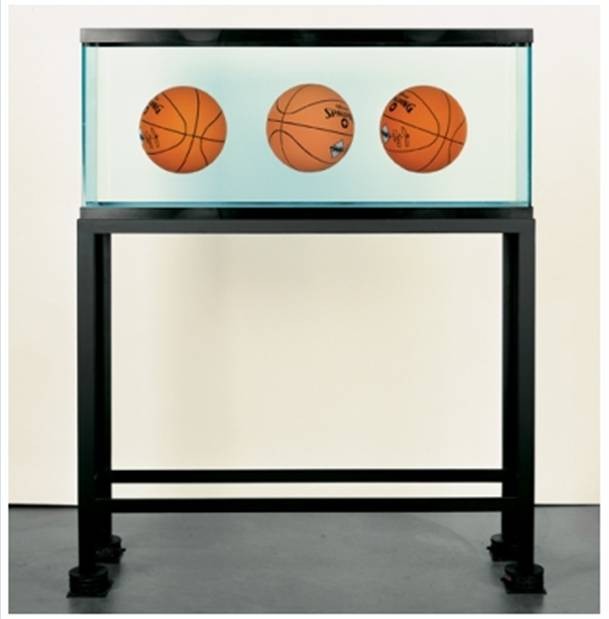Pandora's Box: Joseph Cornell Unlocks the Collection
18 Jun - 16 Oct 2011

Jeff Koons
Three Ball Total Equilibrium Tank, 1985
Collection Museum of Contemporary Art, Chicago, Gerald S. Elliott Collection. Photo © MCA Chicago.
Three Ball Total Equilibrium Tank, 1985
Collection Museum of Contemporary Art, Chicago, Gerald S. Elliott Collection. Photo © MCA Chicago.
PANDORA'S BOX
Joseph Cornell Unlocks the MCA Collection
June 18 - October 16, 2011
Pandora's Box: Joseph Cornell Unlocks the Collection is an exhibition that relies on the deep resources of Joseph Cornell's work within Chicago, as well as the Chicago public's warm familiarity with the American master's work. Because of the constant presence and extensive holdings of Cornell's work at the Art Institute of Chicago, generations have come to appreciate his particular brand of wide-eyed wonder and sly surrealist games. The range of Cornell's interests, the acuity of his vision, and the timelessness of his subjects has allowed his work to stand the test of time, and thus it is no surprise that his influence resonates all the way to the present.
This exhibition puts Cornell's work into direct dialogue with objects from the MCA's collection to illuminate the continued relevance of his pursuits while also grounding even very recent work within a historical continuum that yields surprises to this day. Across more than 60 years, and including media from painting and photography to sculpture and video, the exhibition relies on loose and playful juxtapositions to prompt new appreciations of his career and shows the work in a decidedly different and distinctively contemporary light. Examples of such pairings would be the nascent minimalism of Cornell's rigorously geometric "Dovecotes," which resonate with sculpture by artists such as Sol LeWitt, or later architecturally oriented photographs by Andreas Gursky. Likewise, the repeated imagery found in Cornell's "Medici Slot Machine" sculptures make for prescient harbingers of the work of Andy Warhol, Wallace Berman and others, not to mention the brooding mournfulness of Christian Boltanski's photo-based installations.
Cornell's brash collage aesthetic, where disparate images collide to form surprising new meanings, is also echoed in the work of David Salle, John Baldessari, John Stezaker, and many others from the postmodern generation. The far-reaching ricochets that visitors will glean from such a comparative approach will open up fresh considerations of Cornell's place in art history and allow audiences to see an artist that they thought they knew well in an entirely new way.
Joseph Cornell Unlocks the MCA Collection
June 18 - October 16, 2011
Pandora's Box: Joseph Cornell Unlocks the Collection is an exhibition that relies on the deep resources of Joseph Cornell's work within Chicago, as well as the Chicago public's warm familiarity with the American master's work. Because of the constant presence and extensive holdings of Cornell's work at the Art Institute of Chicago, generations have come to appreciate his particular brand of wide-eyed wonder and sly surrealist games. The range of Cornell's interests, the acuity of his vision, and the timelessness of his subjects has allowed his work to stand the test of time, and thus it is no surprise that his influence resonates all the way to the present.
This exhibition puts Cornell's work into direct dialogue with objects from the MCA's collection to illuminate the continued relevance of his pursuits while also grounding even very recent work within a historical continuum that yields surprises to this day. Across more than 60 years, and including media from painting and photography to sculpture and video, the exhibition relies on loose and playful juxtapositions to prompt new appreciations of his career and shows the work in a decidedly different and distinctively contemporary light. Examples of such pairings would be the nascent minimalism of Cornell's rigorously geometric "Dovecotes," which resonate with sculpture by artists such as Sol LeWitt, or later architecturally oriented photographs by Andreas Gursky. Likewise, the repeated imagery found in Cornell's "Medici Slot Machine" sculptures make for prescient harbingers of the work of Andy Warhol, Wallace Berman and others, not to mention the brooding mournfulness of Christian Boltanski's photo-based installations.
Cornell's brash collage aesthetic, where disparate images collide to form surprising new meanings, is also echoed in the work of David Salle, John Baldessari, John Stezaker, and many others from the postmodern generation. The far-reaching ricochets that visitors will glean from such a comparative approach will open up fresh considerations of Cornell's place in art history and allow audiences to see an artist that they thought they knew well in an entirely new way.
